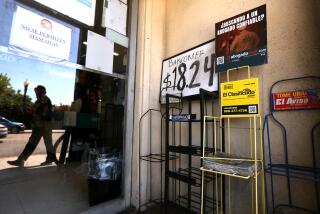Union to Merge With Troubled S.D. Tribune
SAN DIEGO — The San Diego Union and Tribune, whose distinct editorial voices and highly competitive news staffs belied their common ownership for more than six decades, will merge early next year into a single newspaper with morning and afternoon editions, Publisher Helen K. Copley announced Wednesday.
Reflecting a nationwide shift by readers toward morning newspapers, the planned merger stems largely from declining circulation in the afternoon Tribune, a 96-year-old publication which itself merged with two other papers over the past half century.
“The Tribune is a wonderful newspaper, and it’s not that we haven’t tried our very best to maintain it as a separate and independent paper,” said Copley, chairwoman and chief executive officer of Copley Press Inc., which has owned the two papers since 1928. “For many years, we have competed against ourselves.”
The new joint newspaper, to be called the San Diego Union-Tribune, will be a larger paper combining “the best of each newspaper’s news staffs, columnists, features, sections and comics,” Copley said.
Some of the two newspapers’ 1,875 staffers in all departments could be laid off, but neither the extent of the cutbacks nor the manner in which they will be made has been decided, Copley executives said. A committee consisting of top management from both the Union and Tribune will work out details on how the two papers’ staffs will be combined.
Another major uncertainty is whether Union Editor Gerald Warren, Tribune Editor Neil Morgan or a new editor will lead the joint publication.
“Given the inevitable demise of afternoon newspapers, I like the way this is being done,” Morgan said. “These two papers have clobbered each other; now we are going to work together, meld our imprints. It’s going to be fascinating. I expect the best of all possible worlds--that’s what I’m gunning for.”
Typified by a feisty, aggressive style of reporting and a more moderate editorial stance than the staid, staunchly conservative Union, the Tribune won two Pulitzer Prizes over the past dozen years: one for best local reporting in 1979 based on staff coverage of a mid-air collision over San Diego in which 144 people died, and one for editorial writing on immigration affairs in 1987.
“The loss of any newspaper is regrettable, because it eliminates an important voice in the community,” said San Diego City Councilman Bob Filner. “The Tribune developed an independent personality that was extremely useful and will be missed.”
Similarly, Michael Shames, executive director of Utility Consumers Action Network, called the merger “tragic . . . news” that will “reduce competition and reduce the choices that consumers will have for getting their information.”
Despite the two papers’ differences and the fact that only about 3% of their subscriptions overlap, they often have been lumped together in the public consciousness as “the Copley Press”--a phrase treated as a scornful epithet in certain local political, business and social circles.
Accordingly, the merger’s announcement also drew some markedly unsympathetic reaction Wednesday, none more so than that of former San Diego Mayor Roger Hedgecock, who has long complained of what he sees as the papers’ biased news coverage, both of his own career and other issues.
“One down and one to go,” said Hedgecock, now a radio and television talk-show host. “It wasn’t as bad as the Union, but (the Tribune) still was part of what in effect was a bizarre reign of terror by a publisher who tried to determine the community’s political, business and social agenda. With that fig leaf of respectability that the Tribune gave now gone, that issue may come into sharper relief.”
Because there had been consistent rumors about the Tribune’s possible merger, sale or even closure over the past several years, there was more surprise over the timing than the content of Wednesday’s announcement, both inside and outside the two newspapers’ joint Mission Valley publishing plant.
Only several weeks ago, Tribune staffers were assured by Morgan that Copley intended to maintain two separate newspapers for the foreseeable future, according to one Tribune staffer. Despite such assurances, many Tribune employees said they had braced themselves for the inevitability of an announcement similar to Wednesday’s.
“Frankly, we felt it was going to happen,” said David Hasemyer, a Tribune reporter whose wife also writes for the paper. “No matter what assurances we had been given for so long, the trend across the country has not been good for afternoon papers. Most of us were surprised it happened now the way it did. I don’t think we’re shocked that it happened.”
Herb Klein, Copley Newspapers’ editor in chief, said in an interview that the merger decision was made at a management meeting Friday. Previously, the Tribune had been studying other alternatives--including a format change, perhaps to a tabloid-size publication--as a means of bolstering its sagging circulation.
The move was primarily driven by the drop in circulation, although the general economic downturn contributed to the decision, company officials said.
Copley managers, however, decided that the merger offered the “most logical” way of developing “our paper of the future,” Klein explained.
Though crucial details about the merger remain unresolved, Tribune officials decided to announce it Wednesday to prevent news leaks, Klein added.
Founded in 1895, the Tribune was San Diego County’s circulation leader until 1966, but now has less than half of the Union’s readership--116,694, contrasted with 271,068, according to the latest Audit Bureau of Circulation statistics.
“The excellence of the Tribune and its staff simply has been overcome by changing reading habits,” Copley said. “Meanwhile, the San Diego Union has shown major growth annually in the morning field.”
Both the Tribune’s declining circulation, which peaked at 133,711 in 1979, and the planned merger with the morning Union reflect growing trends within the newspaper industry.
Only one of the nation’s top 25 papers is published in the afternoon, and, during the past two years, at least 35 daily newspapers either suspended publication or merged with other papers in cost-cutting moves, according to John Morton, a Washington-based newspaper analyst. The shift toward combined publications is particularly prevalent among joint-owned newspapers, with afternoon papers generally being the victims of the consolidations, Morton added.
“Clearly, the era of the commonly owned morning and evening (paper) is coming to a halt,” Morton said.
In the Tribune newsroom, where Morgan informed staffers about the merger in an early-morning meeting, the news was greeted with both tears and a kind of gallows humor. While some weeping reporters and editors had to be consoled by colleagues, others put hastily scribbled signs on their desks saying “Will Write for Food” and “Going Out of Business Sale.” Among reporters, the merger was quickly dubbed “the Curley shuffle,” a reference to Union-Tribune General Manager John Curley, who circulated a memo outlining the plan to staffers.
“It’s just weird--I don’t know if I will have a job in January,” said Sharon Jones, a Tribune reporter who has been at the paper for three years. “We’ve been expecting this for a long time. It just came sooner than I thought it was going to. I just bought a washer-dryer stackable unit and a black leather couch, and I don’t know whether I should return them.”
Though Union and Tribune staffers were told in separate meetings Wednesday that the job reductions would be equitable at both papers, many Tribune employees fear that Union managers will dictate who stays or is cut from the merged staff.
“Ever hear of a merger where the weak sister came into it as the dominant paper?” James G. Wright, an assistant city editor at the Tribune, asked rhetorically.
Tribune Deputy Editor Robert Witty and Union Managing Editor Karin Winner will head the transition team that will select reporters for the new staff, Morgan said.
“Reporters are asking themselves, ‘Does Bob Witty like me or not?’ ” one reporter said. “It’s gotten down to that.”
After work Wednesday, about 30 Tribune reporters and editors gathered at a Mission Valley hotel bar to glumly recount the irony of being the news rather than reporting it--and to begin to ponder an uncertain future.
“It’s weird to know that we’re a lame-duck newspaper,” Hasemyer said. “In three months, we’re going to cease to exist. That’s something I don’t think has been fully absorbed. I know it’s hard for me to conceive of that. I’ve been here 12 years, 12 1/2 years, and it’s real difficult to conceive that my newspaper is no longer going to exist.”
Times staff writers Alan Abrahamson, Nora Zamichow, Greg Johnson, Michael Granberry, John M. Glionna, Tony Perry and Susan Freudenheim contributed to this story.
TRIBUNE’S DEMISE: Reporters and readers alike are saddened by news of Union-Tribune merger. B1
The Tribune was known for its independent nature. B3
Afternoon newspapers across the nation have been plagued with the inability to attract readers. D1
More to Read
Sign up for Essential California
The most important California stories and recommendations in your inbox every morning.
You may occasionally receive promotional content from the Los Angeles Times.










